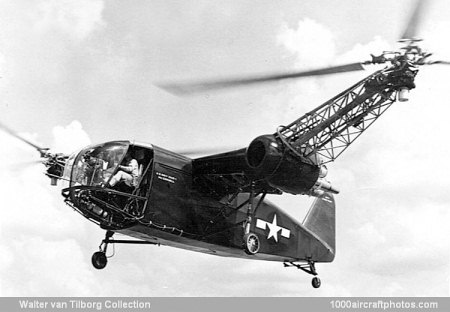The sole example, BuNo. 44318, was originally conceived as an ASW helicopter but was actually built as a flying laboratory to confirm theories on various helicopter rotor parameters. It had side-by-side rotors mounted on outriggers extending from the engines which were themselves mounted on stub wings. In cruise flight the wings could support about ten% of the aircraft's weight. The rotor blades and direction of the rotation as well as other aerodynamic features of the aircraft were varied during the flight test program.
The original tail fin was subsequently supplemented with an externally braced horizontal control surface. The XHJD-1's main landing gear extended down from the engine nacelles and was externally braced; a tail wheel was also fitted. Extensive instrumentation was provided, while the power plant consisted of two 450 hp Pratt & Whitney R-985-AN-14B Wasp Junior radial engines.
The XHJD-1 (site files), named Whirlaway by McDonnell, first flew on April 27, 1946, shortly thereafter it became the XHJH-1 when the USN changed the McDonnell code letter from D to H. It was engaged in test and evaluation until June 1951, and flew with the outer panels of the outriggers both covered and uncovered. Rotor blades of various diameters could be fitted, as were horizontal tail surfaces.
Span, centers of rotor hub: 41 ft 0 in (12.50 m)
Span, overall: 91 ft 0 in (27.74 m)
Rotor diameter initially: 46 ft 0 in (14.02 m)
Rotor diameter: 50 ft 0 in (15.24 m)
Length: 32 ft 2 in (9.80 m)
Height: 12 ft 3 in (3.73 m)
Rotor disk, initially: 1,661 sq.ft (154.30 sq.m) each
Rotor disk: 1,963 sq.ft (182.32 sq.m) each
Weight empty: 7,386 lb (3,350 kg)
Loaded weight: 11,000 lb (4,990 kg)
Max speed: 120 mph (193 kmh)
Cruise speed: 90 mph (145 kmh)
Climb: 1,300 ft (396 m)/min
Service ceiling: 12,900 ft (3,932 m)
Range: 300 mls (483 km)
